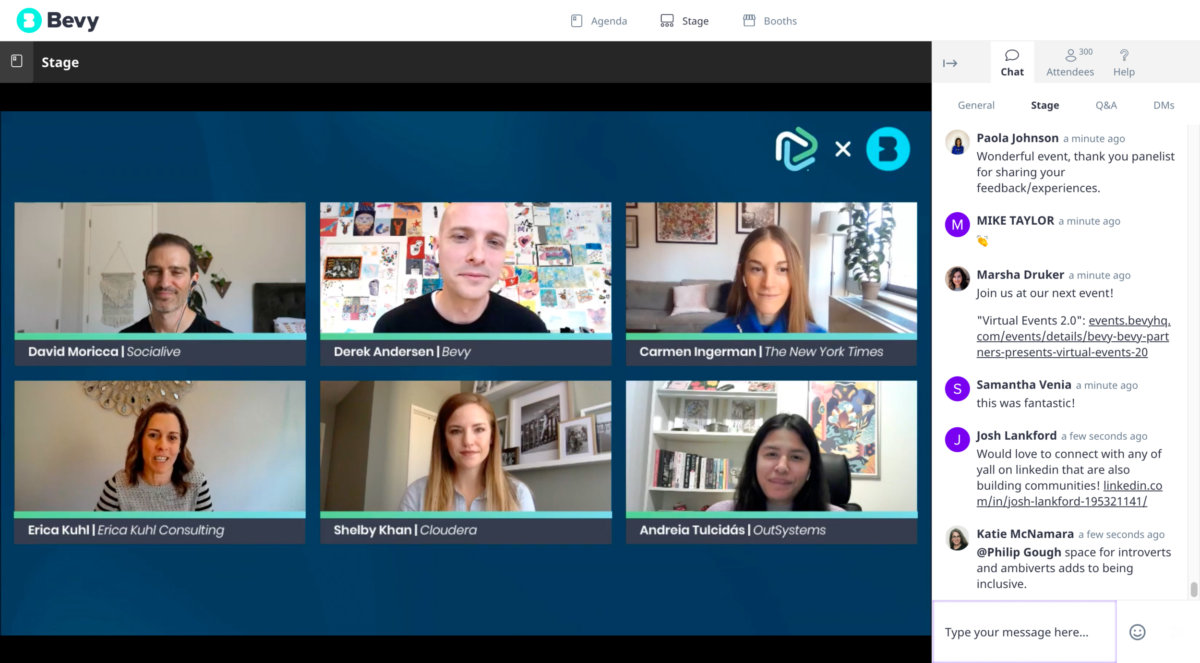Expert tips for winning at virtual events
This year, brands are rethinking their video and community strategy with virtual events at the center.
We partnered up with our friends at Bevy, a leading virtual events platform, to bring together leaders from top companies to discuss topics like the value of content and community in virtual events, as well as key trends and best practices.
On Feb. 24, the panel called “What Virtual Event Attendees Actually Want,” featured Carmen Ingerman from The New York Times, Shelby Khan from Cloudera, Andreia Tulcidás from OutSystems, and Erica Kuhl from Erica Kuhl Consulting. It was moderated by David Moricca, Founder and CEO of Socialive, and Derek Andersen, co-founder and CEO of Bevy.
For those who were unable to attend, we rounded up some valuable takeaways from the conversation.
Quotes have been edited for clarity and brevity.
1. Create content your audience will love
“Initially everybody threw [events] online, and tried to adapt. They quickly realized that was not engagement.
So, what can we do to empower people in our organizations and people in our communities to run awesome events virtually?
It doesn’t necessarily mean doing more of them. It means doing them more effectively, and giving them tools and resources. Invest in your leaders to make them amazing at running their own events. That’s a skill they can bring on forever.”
-Erika Kuhl, CEO & Strategic Community Consultant at Erica Kuhl Consulting
2. Break larger audiences into smaller segments
“We really had to change the way we work together to get to this point. Now we’re going heavily into smaller events – more specific and strategic groups – to drive the engagement we’re looking for as opposed to broad-scale [events] all the time.”
-Shelby Khan, Corporate Communications Manager at Cloudera
3. Experiment to drive audience interaction
“There’s no one size fits all when it comes to events, right? There isn’t one specific thing that works with all communities.
We saw an opportunity to try out new things. Instead of a typical webinar where people look at slides for one or two hours, we opened everything. We insisted on speakers having less slides.
We tried to pump up interaction and engagement. We invited product managers and engineers, and encouraged them to have open conversations. We created breakout rooms. Give [attendees] the space that reminds them of what it was like to be at an [in-person] event.”
-Andreia Tulcidás, Community Engagement Manager at OutSystems
4. Turn your virtual event into a content goldmine
“Ninety percent of our views come after [going live]. What other content can we start putting out here knowing that we’ll get the bulk of the responses after? How do we follow back through on community and make sure we’re responding to questions? The data is driving where our strategies are going. It’s driving innovation that is exciting our whole team.”
-Shelby Khan, Corporate Communications Manager at Cloudera
5. Get creative to build community
“I like to talk and brainstorm, but not everybody has that personality. In person, we don’t all interact the same way.
There’s this cool trick I learned where you ask a prompt, and everyone [types] their answer in the chat without pushing ‘SEND.’ Then, the moderator says “1, 2, 3, everybody click ‘SEND.’”
Then, read through the interactions. Everyone has a unique way to think about it and process it. It’s so small, but a nice way to [engage] people in a virtual world.
-Erika Kuhl, CEO & Strategic Community Consultant at Erica Kuhl Consulting
6. Repurpose valuable event content
“We’ve seen the [virtual] sessions as educational material we can leverage for our developers. These sessions that are provided by experts in the ecosystem get leveraged as our guided path material and training courses. We’re using this knowledge from experts around the world to be consumed afterwards.”
-Andreia Tulcidás, Community Engagement Manager at OutSystems
7. Create a full campaign from virtual events and livestreams
This is a key way to ensure that your event truly produces an ROI. Each time you go live, you have tons of material that you can spin into social posts, snackable clips, thought leadership, and fresh pieces of content. By using a platform that records each user’s input in full, you can quickly spin up new content.
Check out how you can specifically plan out a campaign around LinkedIn in our guide on how to get the most out of each LinkedIn Live.

